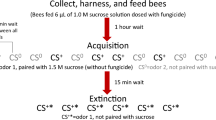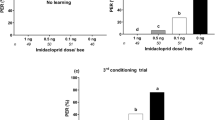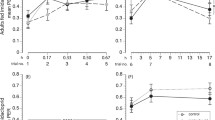Abstract
Using a conditioned proboscis extension response (PER) assay, honeybees (Apis mellifera L.) can be trained to associate an odor stimulus with a sucrose reward. Previous studies have shown that observations of conditioned PER were of interest for assessing the behavioral effects of pesticides on the honeybee. In the present study, the effects of sublethal concentrations of nine pesticides on learning performances of worker bees subjected to the PER assay were estimated and compared. Pesticides were tested at three concentrations. The highest concentration of each pesticide corresponded to the median lethal dose value (48-h oral LD50), received per bee and per day, divided by 20. Reduced learning performances were observed for bees surviving treatment with fipronil, deltamethrin, endosulfan, and prochloraz. A lack of behavioral effects after treatment with λ -cyalothrin, cypermethrin, τ -fluvalinate, triazamate, and dimethoate was recorded. No-observed-effect concentrations (NOECs) for the conditioned PER were derived for the studied pesticides. Our study shows that the PER assay can be used for estimating sublethal effects of pesticides on bees. Furthermore, comparisons of sensitivity as well as the estimation of NOECs, useful for regulatory purposes, are possible.

Similar content being viewed by others
References
CI Abramson IS Aquino FS Ramalho JM Price (1999) ArticleTitleThe effect of insecticides on learning in the Africanized honey bee (Apis mellifera L.) Arch Environ Contam Toxicol 37 529–535
CI Abramson BJ Boyd (2001) ArticleTitleAn automated apparatus for conditioning proboscis extension in honey bees (Apis mellifera L.) J Entomol Sci 36 78–92
CI Abramson J Squire A Sheridan PG Mulder SuffixJr (2004) ArticleTitleThe effect of insecticides considered harmless to honey bees (Apis mellifera L.): Proboscis conditioning studies using the insect growth regulators Confirm®2F (Tebufenozide) and Dimilin®2L (Diflubenzuron) Environ Entomol 33 378–388
M Barnavon (1987) ArticleTitleExpérimentation en laboratoire et en plein champ du fluvalinate. Principes pour un insecticide Défense Végétaux 243 43–49
N Bendahou C Fléché M Bounias (1999) ArticleTitleBiological and biochemical effects of chronic exposure to very low levels of dietary cypermethrin (Cymbush) on honeybee colonies (Hymenoptera: Apidae) Ecotoxicol Environ Saf 44 147–153
ME Bitterman R Menzel A Fietz S Schäfer (1983) ArticleTitleClassical conditioning proboscis extension in honeybees (Apis mellifera) J Comp Psychol 97 107–119 Occurrence Handle10.1037//0735-7036.97.2.107 Occurrence Handle1:STN:280:BiyB28%2FktVw%3D Occurrence Handle6872507
Chalvet-Monfrey K (1996) Synergie entre la deltaméthrine et le prochloraze chez l’abeille (Apis mellifera L.): Hypothèses de mécanismes d’action testées par modélisation. PhD Thesis, University Claude Bernard, Lyon I
S Cluzeau (2002) Risk assessment of plant protection products on honey bees J Devillers MH Pham-Delègue (Eds) Honey bees: estimating the environmental impact of chemicals Taylor and Francis London 42–55
G Curé HW Schmidt R Schmuck (2000) Results of a comprehensive field research programme with the systemic insecticide imidacloprid (Gaucho) LP Belzunces C Pélissier GB Lewis (Eds) Hazards of pesticides to bees INRA Edition Avignon 49–59
FX Dechaume-Moncharmont A Decourtye C Hennequet MH Pham-Delègue O Pons (2003) ArticleTitleStatistical analysis of the honeybee survival after chronic exposure to insecticides Environ Toxicol Chem 22 3088–3094
Decourtye A (2002) Etude de l’impact de produits phytopharmaceutiques sur la survie et l’apprentissage associatif chez l’abeille domestique (Apis mellifera L.). PhD Thesis, University Paris XI, Orsay
A Decourtye MH Pham-Delègue (2002) The proboscis extension response: assessing the sublethal effects of pesticides on the honey bee J Devillers MH Pham-Delègue (Eds) Honey bees: estimating the environmental impact of chemicals Taylor and Francis London 67–84
A Decourtye E Lacassie MH Pham-Delègue (2003) ArticleTitleLearning performances of honeybees (Apis mellifera L.) are differentially affected by imidacloprid according to the season Pest Manag Sci 59 269–278
A Decourtye J Devillers S Cluzeau M Charreton MH Pham-Delègue (2004a) ArticleTitleEffects of imidacloprid and deltamethrin on associative learning in honeybees under semi-field and laboratory conditions Ecotoxicol Environ Saf 57 410–419
A Decourtye C Armengaud M Renou J Devillers S Cluzeau M Gauthier MH Pham-Delègue (2004b) ArticleTitleImidacloprid impairs memory and brain metabolism in the honey bee (Apis mellifera L.) Pestic Biochem Physiol 78 83–92
J Devillers (2002) Acute toxicity of pesticides to honey bees J Devillers MH Pham-Delègue (Eds) Honey bees: estimating the environmental impact of chemicals Taylor and Francis London 56–66
InstitutionalAuthorNameEuropean and Mediterranean Plant Protection Organisation (EPPO) (1992) ArticleTitleGuideline on test methods for evaluating the side-effects of plant protection products on honey bees EPPO Bull 22 203–215
InstitutionalAuthorNameEuropean and Mediterranean Plant Protection Organisation (EPPO) (1993) ArticleTitleDecision-making scheme for the environmental risk assessment of plant protection products. Chapter 10: honeybees EPPO Bull 22 203–215
I Fries K Wibran (1987) ArticleTitleEffects on honey-bee colonies following application of the pyrethroids cypermethrin and PP 321 in flowering oilseed rape Am Bee J 127 266–269
HJ Gough EC MacIndoe (1994) ArticleTitleThe use of dimethoate as a reference compound in laboratory acute toxicity tests on honey bees (Apis mellifera L.) 1981–1992 J Apic Res 33 119–125
H Koch P Weiber (1997) ArticleTitleExposure of honey bee during pesticide application under field conditions Apidologie 28 439–447
M Kuwabara (1957) ArticleTitleBildung des bedingten Reflexes von Pavlovs Typus bei der Honigbiene, Apis mellifica J Fac Sci Hokkaido Univ Ser VI Zool 13 458–464
AN Mamood GD Waller (1990) ArticleTitleRecovery of learning responses by honeybees following a sublethal exposure to permethrin Physiol Entomol 15 55–60
R Menzel U Greggers M Hammer (1993) Functional organization of appetitive learning and memory in a generalist pollinator, the honey bee DR Papaj AC Lewis (Eds) Insect learning Chapman Hall New York 79–125
R Menzel (1999) ArticleTitleMemory dynamics in the honeybee J Comp Physiol A 185 323–340 Occurrence Handle10.1007/s003590050392
Miniggio C, Borneck R, Arnold G (1990) Etudes des effets à long terme des pesticides chez l’abeille Apis mellifera. Comité de l’Ecologie et de la Gestion du Patrimoine Naturel, Ministère de l’Environnement (SRETIE)
S Padilla (1995) ArticleTitleThe neurotoxicity of cholinesterase-inhibiting insecticides: past and present evidence demonstrating persistent effects Inhalation Toxicol 7 903–907
MH Pham-Delègue R Jong ParticleDe C Masson (1990) ArticleTitleEffet de l’âge sur la réponse conditionnée d’extension du proboscis chez l’abeille domestique C R Acad Sci Paris, Ser III 310 527–532
MH Pham-Delègue A Decourtye L Kaiser J Devillers (2002) ArticleTitleMethods to assess the sublethal effects of pesticides on honey bees Apidologie 33 425–432
H Rafalimanana L Kaiser JM Delpuech (2002) ArticleTitleStimulating effects of the insecticide chlorpyrifos on host searching and infestation efficacy of a parasitoid wasp Pest Manag Sci 58 321–328
D Russel R Meyer J Bukowski (1998) ArticleTitlePotential impact of microencapsulated pesticides on New Jersey apiaries Am Bee J 138 207–210
SF Sakagami (1953) ArticleTitleUntersuchungen über die Arbeitsteilung in einem zwergfolk der Honigbiene. Beiträge zur Biologie des Bienenvolkes, Apis mellifera L. I Jpn J Zool 11 117–185
JC Sandoz B Roger MH Pham-Delègue (1995) ArticleTitleOlfactory learning and memory in the honeybee: comparison of different classical conditioning procedures of the proboscis extension response C R Acad Sci Paris Sci vie 318 749–755
JC Sandoz D Laloi JF Odoux MH Pham-Delègue (2000) ArticleTitleOlfactory information transfer in the honeybee: compared efficiency of classical conditioning and early exposure Anim Behav 59 1025–1034
R Schmuck R Schöning A Stork O Schramel (2001) ArticleTitleRisk to honeybees (Apis mellifera L. Hymenoptera) by an imidacloprid seed dressing of sunflowers Pest Manag Sci 57 225–238
TD Seeley (1982) ArticleTitleAdaptative significance of the age polyethism schedule in honeybee colonies Behav Ecol Sociobiol 11 287–293 Occurrence Handle10.1007/BF00299306
RR Sokal FJ Rohlf (1995) Biometry: the principles of practice of statistics in biological research WH Freeman and Co. New York
JH Stevenson (1978) ArticleTitleThe acute toxicity of unformulated pesticides to worker honey bees (Apis mellifera L.) Plant Pathol 27 38–40
JC Stone CI Abramson JM Price (1997) ArticleTitleTask-dependent effects of dicofol (Kelthane) on learning in the honey bee (Apis mellifera) Bull Environ Contam Toxicol 58 177–183
S Suchail D Guez LP Belzunces (2000) ArticleTitleCharacteristics of imidacloprid toxicity in two Apis mellifera subspecies Environ Toxicol Chem 19 1901–1905 Occurrence Handle10.1897/1551-5028(2000)019<1901:COITIT>2.3.CO;2
S Suchail D Guez LP Belzunces (2001) ArticleTitleDiscrepancy between acute and chronic toxicity induced by imidacloprid and its metabolites in Apis mellifera Environ Toxicol Chem 20 2482–2486
K Takeda (1961) ArticleTitleClassical conditioned response in the honey bee J Insect Physiol 6 168–179
KS Taylor GD Waller LA Crowder (1987) ArticleTitleImpairment of classical conditioned response of the honey bee (Apis mellifera L.) by sublethal doses of synthetic pyrethroid insecticides Apidologie 18 243–252
Thompson H, Brobyn T (2002) Sub-lethal effects in honeybees: their significance and use in pesticide risk assessment. 8th International Symposium Hazards of Pesticides to Bees, Bologna, September 4–6
Vaughan A (1986) Cypermethrin: honey bee acute contact and oral LD50. U.S. Environmental Protection Agency, Environmental Effects Branch, February 28
S Villa M Vighi A Finizio G Bolchi Serini (2000) ArticleTitleRisk assessment for honeybees from pesticide-exposed pollen Ecotoxicology 9 287–297
O Wahl K Ulm (1983) ArticleTitleInfluence of pollen feeding and physiological condition on pesticide sensitivity of the honey bee Apis mellifera carnica Oecologia 59 106–128
GD Waller BJ Erikson J Harvey JH Martin (1984) ArticleTitleEffects of dimethoate on honeybees (Hymenoptera: apidae) when applied to flowering lemons J Econ Entomol 77 70–74
J Weick RS Thorn (2002) ArticleTitleEffects of acute sublethal exposure to coumaphos or diazinon on acquisition and discrimination of odor stimuli in the honey bee (Hymenoptera: Apidae) J Econ Entomol 9 227–236
Acknowledgments
We wish to thank M. Charreton and B. Roger for technical assistance in bee rearing. This work benefited from a grant by the French Ministry of the Environment (MATE-01133-Evaluation et réduction des risques lies à l’utilisation des pesticides).
Author information
Authors and Affiliations
Corresponding author
Rights and permissions
About this article
Cite this article
Decourtye, A., Devillers, J., Genecque, E. et al. Comparative Sublethal Toxicity of Nine Pesticides on Olfactory Learning Performances of the Honeybee Apis mellifera . Arch Environ Contam Toxicol 48, 242–250 (2005). https://doi.org/10.1007/s00244-003-0262-7
Received:
Accepted:
Published:
Issue Date:
DOI: https://doi.org/10.1007/s00244-003-0262-7




